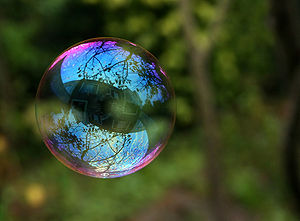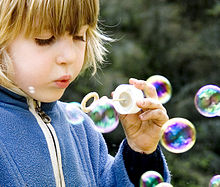- Soap bubble
-
A soap bubble is a thin film of soapy water enclosing air, that forms a hollow sphere with an iridescent surface. Soap bubbles usually last for only a few seconds before bursting, either on their own or on contact with another object. They are often used for children's enjoyment, but they are also used in artistic performances. Assembling several bubbles results in a foam.
Contents
Mathematics
Soap bubbles are also physical illustrations of the complex mathematical problem of minimal surface. They will assume the shape of least surface area possible containing a given volume. A true minimal surface is more properly illustrated by a soap film, which has equal pressure on inside as outside, hence is a surface with zero mean curvature. A soap bubble is a closed soap film: due to the difference in outside and inside pressure, it is a surface of constant mean curvature.
While it has been known since 1884 that a spherical soap bubble is the least-area way of enclosing a given volume of air (a theorem of H. A. Schwarz), it was not until 2000 that it was proven that two merged soap bubbles provide the optimum way of enclosing two given volumes of air of different size with the least surface area. This has been dubbed the double bubble theorem.[1]
Physics
Merging
When two bubbles merge, they adopt a shape which makes the sum of their surface areas as small as possible, compatible with the volume of air each bubble encloses. If the bubbles are of equal size, their common wall is flat. Else, their common wall bulges into the larger bubble, since the smaller one has a higher internal pressure than the larger one, as predicted by the Young–Laplace equation.
At a point where three or more bubbles meet, they sort themselves out so that only three bubble walls meet along a line. Since the surface tension is the same in each of the three surfaces, the three angles between them must be equal to 120°. This is the most efficient choice, again, which is also the reason why the cells of a beehive have the same 120° angle and form hexagons. Only four bubble walls can meet at a point, with the lines where triplets of bubble walls meet separated by cos−1(−1/3) ≈ 109.47°. All these rules, known as Plateau's laws, determine how a foam is built from bubbles.
Stability
The longevity of a soap bubble is limited by the rupture of the very thin layer of water which constitutes its surface, namely a micron-thick soap film. It is thus sensitive to :
- Drainage within the soap film: water falls down due to gravity. This can be slowed down by increasing the water viscosity, for instance by adding glycerol. Still, there is an ultimate height limit, which is the capillary length, very high for soap bubbles: around 4 metres. In principle, there is no limit in the length it can reach.
- Evaporation: this can be slowed down by blowing bubbles in a wet atmosphere, or by adding some sugar to the water.
- Dirt and fat: when the bubble touches the ground, a wall, or our skin, it usually results in the soap film rupture. This can be prevented by wetting these surfaces with water (preferably containing some soap).
Bubbles in education
Bubbles can be effectively used to teach and explore a wide variety of concepts to even young children. Flexibility, color formation, reflective or mirrored surfaces, concave and convex surfaces, transparency, a variety of shapes (circle, square, triangle, sphere, cube, tetrahedron, hexagon), elastic properties, comparative sizing... as well as the more esoteric properties of bubbles listed on this page. Bubbles are useful in teaching concepts starting from 2 years old and into college years. A Swiss university professor, Dr. Natalie Hartzell, has theorized that usage of artificial bubbles for entertainment purposes of young children has shown a positive effect in the region of the child's brain that controls motor skills and is responsible for coordination with children exposed to bubbles at a young age showing measurably better motion skills that those who were not. [2]
Fun
Use in play
17th century Flemish paintings show children blowing bubbles with clay pipes[citation needed] verifying soap bubbles being used as entertainment for at least 400 years. The London based firm of A. & F. Pears created a famous advertisement campaign for its soaps in 1886 using a painting by Millais of a child playing with bubbles. A Chicago company called Chemtoy began selling bubble solution in the 1940s, and they have been popular with children ever since. According to one industry estimate, retailers sell around 200 million bottles annually.[citation needed])
Coloured bubbles
A bubble is made of transparent water enclosing transparent air. However the soap film is as thin as the visible light wavelength, resulting in interferences. This creates iridescence which, together with the bubble spherical shape and fragility, contributes to its magical effect on children and adults alike. However, it has become a challenge to produce artificially coloured bubbles.
Adding coloured dye to bubble mixtures fails to produce coloured bubbles, because the dye attaches to the water molecules as opposed to the surfactant. Therefore, a colourless bubble forms with the dye falling to a point at the base. Dye chemist Dr. Ram Sabnis has developed a lactone dye that sticks to the surfactants, enabling brightly coloured bubbles to be formed. Crystal violet lactone is an example. Another man named Tim Kehoe invented a coloured bubble which loses its colour when exposed to pressure or oxygen, which he is now marketing online as Zubbles, which are non-toxic and non-staining. In 2010, Japanese astronaut Naoko Yamazaki demonstrated that it is possible to create coloured bubbles in microgravity. The reason is that the water molecules are spread evenly around the bubble in the low-gravity environment.
Freezing
Soap bubbles blown into air that is below a temperature of −15 °C (5 °F) will freeze when they touch a surface. The air inside will gradually diffuse out, causing the bubble to crumble under its own weight. At temperatures below about −25 °C (−13 °F), bubbles will freeze in the air and may shatter when hitting the ground. When a bubble is blown with warm air, the bubble will freeze to an almost perfect sphere at first, but when the warm air cools, and a reduction in volume occurs, there will be a partial collapse of the bubble. A bubble, created successfully at this low temperature, will always be rather small; it will freeze quickly and will shatter if increased further.[citation needed]
Art
Soap bubble performances combine entertainment with artistic achievement. They require a high degree of skill. Some performers use common commercially available bubble liquids while others compose their own solutions. Some artists create giant bubbles or tubes, often enveloping objects or even humans. Others manage to create bubbles forming cubes, tetrahedra and other shapes and forms. Bubbles are sometimes handled with bare hands. To add to the visual experience, they are sometimes filled with smoke, vapour or helium and combined with laser lights or fire. Soap bubbles can be filled with a flammable gas such as natural gas and then ignited.
See also
References
- ^ Hutchings, Michael; Morgan, Frank; Ritoré, Manuel; Ros, Antonio (July 17, 2000). "Proof of the double bubble conjecture". Electronic Research Announcements (American Mathematical Society) 6 (06): 45–49. doi:10.1090/S1079-6762-00-00079-2.
- ^ http://www.jstor.org/pss/1970949
Further reading
- Oprea, John (2000). The Mathematics of Soap Films – Explorations with Maple. American Mathematical Society (1st ed.). ISBN 0-8218-2118-0
- Boys, C. V. (1890) Soap-Bubbles and the Forces that Mould Them; (Dover reprint) ISBN 0-486-20542-8. Classic Victorian exposition, based on a series of lectures originally delivered "before a juvenile audience".
- Isenberg, Cyril (1992) The Science of Soap Films and Soap Bubbles ; (Dover) ISBN 0-486-26960-4.
- Noddy, Tom (1982) "Tom Noddy's Bubble Magic" Pioneer bubble performer's explanations created the modern performance art.
- Stein, David (2005) "How to Make Monstrous, Huge, Unbelievably Big Bubbles"; (Klutz) Formerly "The Unbelievable Bubble Book" (1987) it started the giant bubble sport. ISBN 978-1-57054-257-2
External links
- Videos of Bubble and Droplet Interactions
- A more detailed scientific explanation
- Performances with bubbles and giant bubbles
Micelles, HLB Surface rheology, adsorption Langmuir through, ellipsometry, Xray, surface rheology Films Frankel's law Surface tension, DLVO, disjoining pressure dewetting, bursting Marangoni, surface rheology Interferometry, Thin film balance Interferences double bubble theorem Giant films Bubbles shape, Plateau's laws foam drainage T1 process acoustics, electric Interferences double bubble theory Giant bubbles, coloured bubbles, freezing Foam Liquid fraction, metastable state Coalescence, avalanches, coarsening, foam drainage rheology light scattering acoustics, conductimetry, Surface Evolver, bubble model, Potts' model acoustics, light scattering light scattering Packing and topology Aquafoams Categories:- Continuum mechanics
- Fluid dynamics
- Minimal surfaces
- Bubbles
- Physical activity and dexterity toys
Wikimedia Foundation. 2010.







